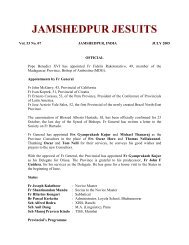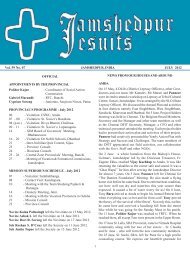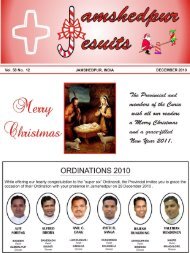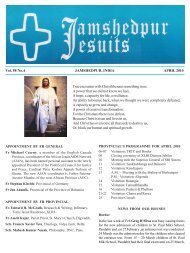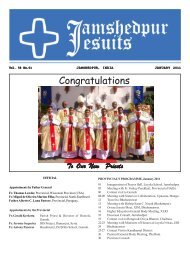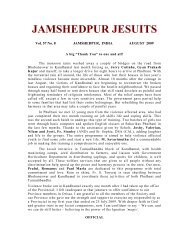Click here to download - Jamshedpur Jesuits
Click here to download - Jamshedpur Jesuits
Click here to download - Jamshedpur Jesuits
Create successful ePaper yourself
Turn your PDF publications into a flip-book with our unique Google optimized e-Paper software.
Roots<br />
By Hedwig Lewis, SJ<br />
Overview<br />
The text of the life-his<strong>to</strong>ry of<br />
Ignatius Loyola is the last testament<br />
- a personal legacy - that the saint<br />
bequeathed <strong>to</strong> the Society of Jesus that<br />
he founded. He did not write it himself,<br />
but dictated it <strong>to</strong> a younger companion<br />
and confidante, Fr Luis Goncalves da<br />
Camara.<br />
Ignatius narrated his accounts in<br />
three periods: August-September 1553;<br />
March 1555; and Oc<strong>to</strong>ber 1555, when<br />
da Camara had <strong>to</strong> leave for Portugal.<br />
Ignatius never resumed his s<strong>to</strong>ries. The<br />
Au<strong>to</strong>biography covers only 18 (1521-<br />
1538) of the 65 years of his life (1491-<br />
1556). Most of the text was read by<br />
Ignatius before his death in July 1556<br />
and he seemed content with the younger<br />
man’s precise memory of the spoken<br />
account. The last chapter (ch 11) spans<br />
as many years as the previous ten put<br />
<strong>to</strong>gether.<br />
Purpose<br />
Fr Jeronimo Nadal made frequent<br />
and fervent requests <strong>to</strong> Ignatius <strong>to</strong><br />
tell how God guided him from the<br />
beginning of his conversion, so that<br />
his account might be for his sons a sort<br />
of testament and paternal instruction.<br />
Though Ignatius was reluctant, he<br />
decided “<strong>to</strong> narrate all that had occurred<br />
in his soul” for the benefit of the<br />
Society.<br />
This is a spiritual au<strong>to</strong>biography.<br />
Ignatius reveals not what he had done<br />
for God but what God had deigned <strong>to</strong><br />
do in him and through him. So, not<br />
Ignatius, but God stands at the centre<br />
of the Au<strong>to</strong>biography. The person of<br />
Ignatius effaces itself, and the s<strong>to</strong>ry is<br />
<strong>to</strong>ld in the third person, by a “pilgrim”<br />
- as Ignatius prefers <strong>to</strong> call himself.<br />
For Nadal, Ignatius’s s<strong>to</strong>ry was<br />
somehow the s<strong>to</strong>ry of every Jesuit. In<br />
an exhortation at Alcala in 1561, he said<br />
that in Ignatius one saw “the first form<br />
and grace” God gave <strong>to</strong> the Society. At<br />
Cologne in 1567 he stated: “The whole<br />
life of the Society is contained in germ<br />
and expressed in Ignatius’s s<strong>to</strong>ry.”<br />
Titles<br />
Da Camara left his document<br />
without a title. Nadal put one in his<br />
Au<strong>to</strong>biography<br />
of Ignatius<br />
The s<strong>to</strong>ry<br />
behind the s<strong>to</strong>ry<br />
own copy: The Acts of Father Ignatius,<br />
as Father Luis Goncalves First wrote Them,<br />
Receiving Them from the Mouth of the<br />
Father Himself. Modern transla<strong>to</strong>rs and<br />
edi<strong>to</strong>rs have given it many titles such<br />
as The Pilgrim S<strong>to</strong>ry, or Testament, Acts,<br />
Memoirs. These titles point <strong>to</strong> the special<br />
nature of the narrative. It is a personal<br />
account of Ignatius’s life, but one in<br />
which he chooses and recalls specific<br />
events and experiences for the benefit of<br />
the early <strong>Jesuits</strong>. It has been translated<br />
in<strong>to</strong> many languages with the most<br />
common title, Au<strong>to</strong>biography.<br />
Reservations<br />
Not everyone appreciated the<br />
picture of Ignatius which emerged from<br />
da Camara’s pen. A free Latin version<br />
was produced very early by Fr Anibal<br />
du Coudray and later printed but never<br />
really circulated. In 1567, Francis Borgia,<br />
the <strong>Jesuits</strong>’ third General, recalled all the<br />
copies of the Au<strong>to</strong>biography so as <strong>to</strong><br />
clear the way for Ribadeneira’s “true”<br />
account of the founder’s life: “The<br />
Provincials are <strong>to</strong> make a good job of<br />
gathering in what Fr Louis Gonsalves<br />
da Camara wrote, or any other writing<br />
about the life of our Father, and they are<br />
<strong>to</strong> keep them and not permit them <strong>to</strong><br />
be read or <strong>to</strong> be circulated among our<br />
people or others. For being an imperfect<br />
thing, it is not appropriate that it cause<br />
problems.”<br />
Some months later Ribadeneira,<br />
answering a query from Nadal,<br />
comments that: “The gathering in of<br />
Fr Luis Gonsalves’ writings about the<br />
life of our Father did not originate<br />
with me, but from the fathers who<br />
remembered our Father. And it seemed<br />
a good idea <strong>to</strong> his paternity so that when<br />
what is written gets published it should<br />
not appear that t<strong>here</strong> be divergence or<br />
contradiction or that the work does<br />
not have as much authority as what<br />
was written almost from the mouth of<br />
the Father.”<br />
T<strong>here</strong> seems <strong>to</strong> have been some<br />
embarrassment about the way Ignatius<br />
expressed himself and possibly some<br />
disappointment <strong>to</strong>o. The narrative<br />
is most unsatisfac<strong>to</strong>ry as a piece of<br />
literature. To a casual reader it seems<br />
<strong>to</strong> be just a patchwork of random<br />
memories, ranging from the trivial <strong>to</strong><br />
the profoundly significant. But looking<br />
closely at the details and the sequence of<br />
eleven chapters we discover a connecting<br />
thread and pedagogy in them.<br />
Retrieval<br />
It is surprising that after it had been<br />
obtained at such cost, the Au<strong>to</strong>biography<br />
was never published, either in the<br />
original or in translations in<strong>to</strong> modern<br />
languages, till the 20th century. The<br />
Bollandists included a Latin translation<br />
in Acta Sanc<strong>to</strong>rum in 1731. The original<br />
Spanish was edited and published by<br />
the His<strong>to</strong>rical Institute of the Society of<br />
Jesus in 1904. The first translation in<strong>to</strong><br />
a modern language was in English. Two<br />
“loose” translations appeared precisely<br />
in 1900, both by <strong>Jesuits</strong>: one American,<br />
J.F.X. O’Connor; the other British, E.<br />
M. Rix.<br />
Today the document is regarded as<br />
a spiritual classic and a masterpiece of<br />
self- revelation in its very clumsiness. The<br />
remarkable renewal in the appreciation<br />
and use of the Spiritual Exercises is<br />
in large measure due <strong>to</strong> the current<br />
understanding in the light of the insights<br />
provided by the Au<strong>to</strong>biography. It supplies<br />
extensive information indispensable for<br />
understanding the rest of Ignatius’<br />
writings with accuracy and depth. •<br />
JIVAN: News and Views of <strong>Jesuits</strong> in India NOVEMBER-DECEMBER 2012 17



